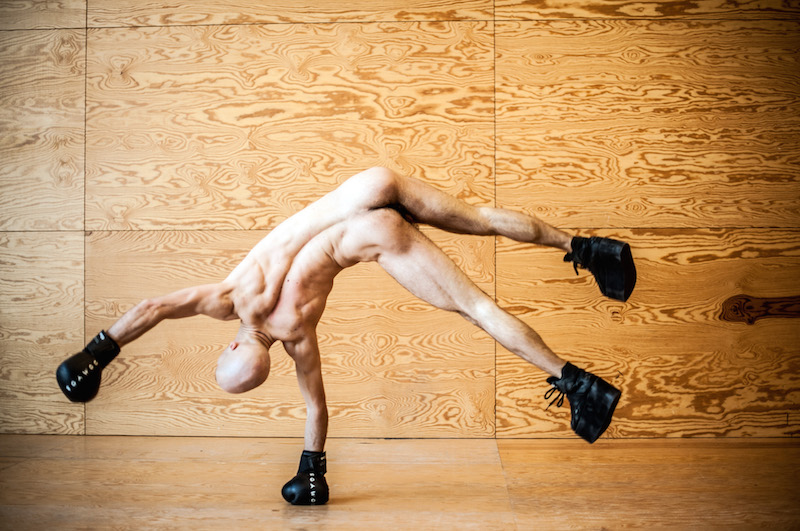Jackson’s Lane, London International Mime Festival; 23rd January, 2016

Alexander Vantournhout has been rather the poster child for contemporary circus lately, as images and reference to the prize-winning ANECKXANDER (the artist’s second show) seem to have been regularly crossing my line of sight over the last year. The one-man performance is more amusing than I had anticipated from the stark photographs, and also more referential to the wider institution of circus: what it means to be a performer, what it means to be an audience member.
Vantournhout teeters on the brink of clown when he turns his wide blue eyes to look at us, to take us in, but runs closer to the tradition of the royal fool, allowed to turn propriety on its head to provide piercing observations under the guise of absurdity. We’re clearly shown the gruelling lengths to which circus performers will go to push their bodies and impress an audience, which leaves me feeling slightly uncomfortable about my complicity in completing the circle with my gaze. This aside from the very real winces and recoils I find myself enacting as Vantournhout throws himself to the ground with increasing force, in ways that make his breath catch in his throat.

Only seconds into the performance, his clothes disappear in a delightful moment of unexpected quick change magic and, for the rest of the show, Vantournhout’s acrobatic and contorting body is completely unmasked (with the exception of a pair of black platform-soled boots, matching boxing gloves, and a white ruff for the neck that are gradually added to his person to increase the difficulty level of his routines onstage).
The stage itself is a bare square of white dance matting, hemmed on three sides by neatly dotted rows of electric heaters, and on the fourth by us, the audience. At the beginning of the show, a suited Vantournhout enters via an upstage door, lugging an electric keyboard and his other costume accessories. In a very pedestrian manner, he then proceeds to lay them into position around the sides of his square.
The keyboard is used over the course of the show to slowly build up a repeated tune between sections of physical movement, in which Vantournhout shows us things that a human body can do that it usually doesn’t. The poses and sequences are well picked to tickle us with their improbability, and the extreme nature of Vantournhout’s balance and muscular control is so well-honed as to be invisible.
As the tune he plays grows in complexity, so too does my thinking around what he is showing us. I enjoy the thinking, trying to draw out interpretations, but this is not a show that hands you meaning on a plate. ANECKXANDER is billed as ‘a tragic autobiography of the body’ and, like all the best autobiographies, it is the universal in the author’s own personal experience that gives it resonance.

The show has been created as part of a KASK School of Arts research project, Between Being and Imagining: towards a methodology for artistic research in contemporary circus, in collaboration with Bauke Lievens, who is making her own mark as a dramaturg with strong notions of how circus arts should progress. I would have loved to stay for the post-show talk to find out more about this work and the pair’s research process, but was called away by the last train home.
I would have asked about the support bandage around Vantournhout’s ankle. It’s such a common sight in circus performance that my eyes blot it out of the picture, as incidental as eye colour. But, within this show where the endurance and suffering of professional performers is put on a pedestal instead of glamoured away behind fishnets and glitter, it suddenly becomes pertinent. If the bandage is a costuming choice rather than a happy accident, it’s a very clever one in my eyes.
The show ends after 50 minutes but, as we are warned beforehand, the ending is an open one: Vantournhout remains on stage, and we are free to stay or go as we please. As he continues to play, there is an interesting shift in power. Now, the remaining audience spilt their attention between Vantournhout’s antics, their own conversations, toilet trips and seat swaps, but what he does remains largely the same. The lack of formal setting, the end of ‘This Is A Show’, invests the still performing body with some of that tragedy the show’s tagline claims. I wonder briefly if this is an experiment into catching our attention… but then my time is up and I have to leave.
It occurs to me that circus can be described as a cross between poetry and showing off. ANECKXANDER manages just that, and adds a couple of giggles for good measure.





“A cross between poetry and showing off” is about as good a definition of circus as we’re ever likely to come across. I can’t think of any circus act it doesn’t cover. You’ve nailed it!